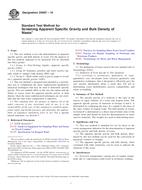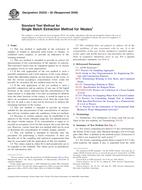Potrebujeme váš súhlas na využitie jednotlivých dát, aby sa vám okrem iného mohli ukazovať informácie týkajúce sa vašich záujmov. Súhlas udelíte kliknutím na tlačidlo „OK“.
ASTM D5526-12
Standard Test Method for Determining Anaerobic Biodegradation of Plastic Materials Under Accelerated Landfill Conditions
Automaticky preložený názov:
Štandardná skúšobná metóda pre stanovenie anaeróbnej biologickej odbúrateľnosti plastov za urýchlených skládkach odpadov podmienky
NORMA vydaná dňa 1.5.2012
Informácie o norme:
Označenie normy: ASTM D5526-12
Poznámka: NEPLATNÁ
Dátum vydania normy: 1.5.2012
Kód tovaru: NS-31551
Počet strán: 6
Približná hmotnosť: 18 g (0.04 libier)
Krajina: Americká technická norma
Kategória: Technické normy ASTM
Kategórie - podobné normy:
Anotácia textu normy ASTM D5526-12 :
Keywords:
accelerated landfill, anaerobic biodegradation, biodegradation, dry digestion, ecotoxicity, landfill, metabolites, plastics, test method, ICS Number Code 13.030.40 (Installations and equipment for waste disposal and treatment)
Doplňujúce informácie
| Significance and Use | ||||||||||||||||||||
|
Decomposition of a plastic within a landfill involves biological processes that will affect the decomposition of other materials enclosed by, or in close proximity to, the plastic. Rapid degradation of the plastic has the ability to increase the economic feasibility of landfill-gas recovery, minimize the duration of after-care of the landfill, and make possible the recovery of the volume reduction of the waste due to biodegradation during the active life of the landfill. This procedure has been developed to permit determination of the anaerobic biodegradability of plastic products when placed in biologically active environments simulating landfill conditions. As degradation occurs inevitably in a landfill, it is of immediate concern that the plastic materials do not produce toxic metabolites or end products under the various conditions that have the potential to occur in a landfill. The mixtures remaining after completion of the test method, containing fully or partially degraded plastic materials or extracts, can be submitted subsequently to ecotoxicity testing in order to assess the environmental hazards posed by the breakdown of plastics to varying degrees in landfills. This test method has been designed to assess biodegradation under optimum and less-than-optimum conditions. Limitations—Because a wide variation exists in the construction and operation of landfills, and because regulatory requirements for landfills vary greatly, this procedure is not intended to simulate the environment of all landfills. However, it is expected to closely resemble the environment of a biologically active landfill. More specifically, the procedure is intended to create a standard laboratory environment that permits rapid and reproducible determination of the anaerobic biodegradability under accelerated landfill conditions, while at the same time producing reproducible mixtures of fully and partially decomposed household waste with plastic materials for ecotoxicological assessment. |
||||||||||||||||||||
| 1. Scope | ||||||||||||||||||||
|
1.1 This test method covers determination of the degree and rate of anaerobic biodegradation of plastic materials in an accelerated-landfill test environment. This test method is also designed to produce mixtures of household waste and plastic materials after different degrees of decomposition under conditions that resemble landfill conditions. The test materials are mixed with pretreated household waste and exposed to a methanogenic inoculum derived from anaerobic digesters operating only on pretreated household waste. The anaerobic decomposition occurs under dry (more than 30 % total solids) and static nonmixed conditions. The mixtures obtained after this test method can be used to assess the environmental and health risks of plastic materials that are degraded in a landfill. 1.2 This test method is designed to yield a percentage of conversion of carbon in the sample to carbon in the gaseous form under conditions that resemble landfill conditions. It is possible that this test method will not simulate all conditions found in landfills, especially biologically inactive landfills. This test method more closely resembles those types of landfills in which the gas generated is recovered or even actively promoted, or both, for example, by inoculation (codeposition of anaerobic sewage sludge and anaerobic leachate recirculation), moisture control in the landfill (leachate recirculation), and temperature control (short-term injection of oxygen and heating of recirculated leachate) (1-7). 1.3 This test method is designed to produce partially degraded mixtures of municipal solid waste and plastics that can be used to assess the ecotoxicological risks associated with the anaerobic degradation of plastics after various stages of anaerobic biodegradation in a landfill. 1.4 Claims of performance shall be limited to the numerical result obtained in the test and not be used for unqualified “biodegradable” claims. Reports shall clearly state the percentage of net gaseous carbon generation for both the test and reference samples at the completion of the test. Furthermore, results shall not be extrapolated past the actual duration of the test. 1.5 The values stated in SI units are to be regarded as the standard. 1.6 This standard does not purport to address all of the safety concerns, if any, associated with its use. It is the responsibility of the user of this standard to establish appropriate safety and health practices and determine the applicability of regulatory limitations prior to use. Specific hazards statements are given in Section 8. Note 1—There is no known ISO equivalent to this standard. |
||||||||||||||||||||
| 2. Referenced Documents | ||||||||||||||||||||
|
Podobné normy:
Historická
1.9.2012
Historická
1.12.2010
Historická
1.1.2012
Historická
15.9.2008
Historická
1.9.2009
Historická
1.2.2007



 ASTM D4982-12
ASTM D4982-12 ASTM D5057-10
ASTM D5057-10 ASTM D5058-12
ASTM D5058-12 ASTM D5088-02(2008)..
ASTM D5088-02(2008).. ASTM D5233-92(2009)..
ASTM D5233-92(2009).. ASTM D5468-02(2007)..
ASTM D5468-02(2007)..
 Cookies
Cookies
